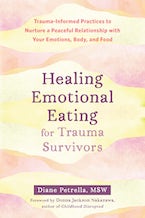By Diane Petrella, MSW, author of Healing Emotional Eating for Trauma Survivors
When food helps you cope, you’re not only eating to satisfy physical hunger. You’re eating to numb emotional pain and calm the stress in your body. Intuitive eating is a non-diet approach to eating and living a healthy lifestyle—freeing you from the rigid constraints of diet culture. But when eating is the way you cope with the pain of childhood trauma, it can feel hard to stop emotionally eating and develop intuitive eating skills.
A foundational principle of intuitive eating is to notice when your body is hungry and when it feels full. Noticing your body’s inner signals and sensations is called interoceptive awareness. This awareness includes physiological sensations such as hunger and satiety, and also emotional sensations such as anxiety or fear. Attuned interoceptive awareness helps you honor your body’s needs to live an intuitive eating lifestyle.
Sounds like a positive and achievable goal, right? Yet, if you’re one of thousands of people with a history of early trauma and abuse and you struggle with emotional eating, you may have a harder time noticing what your body is communicating to you. This is not failure on your part. Intuitive eating may feel inaccessible because the physiological and emotional effects of trauma—unsettling sensations, underlying anxiety, uneasiness, and suppressed and repressed memories—stay stored in the body. These trauma-based emotions can block you from noticing your body’s hunger/fullness signs.
For example, you’ve probably noticed that physical hunger and emotional hunger sometimes feel intertwined. It’s hard to know if you’re hungry for food when emotional hunger and stress leave you craving for something—anything—to fill a deeper void or calm the anxiety in your body. Searching your refrigerator for an evening snack—right after eating dinner—may seem to satisfy your hunger. Or maybe it’s numbing the sadness triggered by another Saturday night alone.
Am I hungry? Or am I sad and lonely?
Sometimes it’s hard to tell the difference.
Early trauma and abuse, especially when chronic, causes nervous system dysregulation. The brain’s normal reaction to threats—the fight-flight-freeze response activated by the part of the brain called the amygdala—intensifies. This makes you hypersensitive to stress so that your body and emotions easily become dysregulated: You feel overwhelmed and experience unsettling sensations in your body. For example, your breathing quickens; you get a sinking feeling in your gut. You feel anxious and afraid, or shut down and go numb.
In this stressed state, you emotionally eat to ground yourself even when your body doesn’t need food. Learning how to calm your nervous system will help because a calm body helps you feel safe. When you and your body feel safe, you’re better able to identify the difference between physical hunger and emotional overwhelm. This body awareness helps you make mindful— rather than impulsive—self-care choices, and opens the space to discover ways to soothe yourself without using food.
Here are four simple and practical ways to develop a more connected relationship with your body and help move you on the path to becoming an intuitive eater.
1. Learn your body’s emotional cues.
Noticing your body’s hunger/fullness signs is a foundational intuitive eating skill. But these signs may be hard to notice when emotional hunger is misread as physical hunger. That’s why it’s important to learn how your body and nervous system communicate emotion to you.
Throughout the day, check in with your body. Use this simple five-point body-awareness scale to notice and gauge how calm or unsettled your body feels.
1 – I feel calm and peaceful.
2 – I feel at ease.
3 – I feel a little unsettled.
4 – I feel very unsettled.
5 – I feel overwhelmed.
What number represents how you and your body feel right now? If you’re at a three, four, or five on the scale, use the following breathing exercise.
2. Breathe to settle your body.
Box breathing, also known as four-step breathing, helps you activate your body’s natural relaxation response. This proven practice, with roots in Hindu pranayama breathing, helps calm your body and reduce stress. Here’s what you do:
1. Breathe in to the count of four.
2. Hold the breath for four counts.
3. Exhale for four counts.
4. Hold the breath for four counts.
5. Repeat the sequence three or four times.
(If four counts feels too long, use three.)
When you’re at a three or higher on the above body-awareness scale, use box breathing. This can help you feel calmer and reduces the likelihood that your body becomes highly dysregulated. As you feel calmer and safe in your body, you’re then less apt to impulsively use food to reduce the overwhelm.
Develop the daily habit of using box breathing to give yourself moments of peace and relaxation. The more you condition your body to feel relaxed, the easier it is to settle yourself when your body is dysregulated.
3. Take your body for a walk.
I’m not talking about walking for exercise, although that’s important. I want you to think of walking as a way to make friends with your body. Schedule quality time with it like you would make a date with a close friend.
Plan about ten, fifteen, or twenty minutes once a week and take your body for a walk. If walking is hard or you’re a person who uses a wheelchair, give your body light stretching or chair yoga movements. Whether walking or stretching, do this by yourself. This time is for you and your body, and not to be shared with a friend.
Walking dates are a good way to get acquainted with your body and develop interoceptive awareness. Since walking can calm your nervous system, it can feel easier to focus on your body while moving. As you walk, notice what’s happening in your body. For example, notice the rhythm of your breathing. Is it rapid and shallow or even and deep? Notice your emotional state. Does your body feel agitated and tense, or peaceful and calm? Draw your attention to your arms and legs. Do they feel sluggish and heavy, or sturdy and strong? Notice, as best you can, how hungry, full, or satisfied you feel.
Use this time to also offer appreciation to your body. For example, you can say:
“Thank you, eyes, for allowing me to see these trees.”
“Thank you, lungs, for allowing me to breathe.”
“Thank you, body, for all you do for me.”
As you walk, stay tuned in to your body as best you can while gifting it messages of appreciation. Your intention is to spend quality, focused time with your body—with no judgment or expectation—to convey that you’re making it a priority, listening to its messages, and want to be its friend.
4. Talk to your body with respect.
Your body has a consciousness of its own, and you regularly communicate with it with your thoughts and words. When you tell your body that you “hate” it or call it “ugly,” your body’s health and energy level weaken. Imagine talking to a friend that way. Your relationship would suffer, right? And so does the relationship with your body.
Think of your body as your BFF or a young child entrusted to your care. It needs you to speak to it with love and kindness. I know that’s sometimes hard to do, especially when you’re struggling with body shame and self-loathing. That’s okay. You’re human and doing the best you can. When you’re upset with your body and speak to it harshly, please don’t judge yourself. Simply apologize and say to your body, “I’m sorry for speaking to you that way.” Then let your body know that you will do your best to nourish it with loving words.
Begin right now and say to your body, “I promise to feed you kind words and thoughts.”
Practice Makes Progress
These four simple practices convey love and respect to your body. You’re communicating that you want to know what it needs and are willing to give it your time and thoughtful attention. As you connect with your body in these ways, interoceptive awareness expands and, over time, this awareness helps you move toward a freedom-filled lifestyle of intuitive eating and mindful self-care.
Diane Petrella, MSW, is a clinical social worker and holistic psychotherapist specializing in childhood trauma and emotional eating. She has a private psychotherapy practice in Providence, RI. You can find out more about Diane at www.dianepetrella.com.



 2024 Peace Playbook: 3 Tactics to Avoid Clashes with Your Partner
2024 Peace Playbook: 3 Tactics to Avoid Clashes with Your Partner